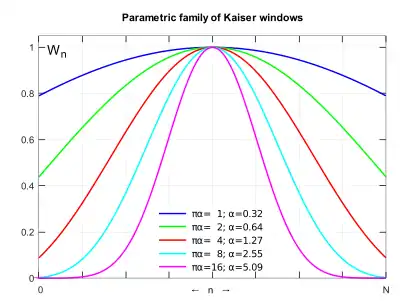Kaiser window
The Kaiser window, also known as the Kaiser–Bessel window, was developed by James Kaiser at Bell Laboratories. It is a one-parameter family of window functions used in finite impulse response filter design and spectral analysis. The Kaiser window approximates the DPSS window which maximizes the energy concentration in the main lobe[1] but which is difficult to compute.[2]

Definition
The Kaiser window and its Fourier transform are given by:

where:
- I0 is the zeroth-order modified Bessel function of the first kind,
- L is the window duration, and
- α is a non-negative real number that determines the shape of the window. In the frequency domain, it determines the trade-off between main-lobe width and side lobe level, which is a central decision in window design.
- Sometimes the Kaiser window is parametrized by β, where β = πα.
For digital signal processing, the function can be sampled symmetrically as:
where the length of the window is and N can be even or odd. (see A list of window functions)
In the Fourier transform, the first null after the main lobe occurs at which is just in units of N (DFT "bins"). As α increases, the main lobe increases in width, and the side lobes decrease in amplitude. α = 0 corresponds to a rectangular window. For large α, the shape of the Kaiser window (in both time and frequency domain) tends to a Gaussian curve. The Kaiser window is nearly optimal in the sense of its peak's concentration around frequency [5]
Kaiser–Bessel-derived (KBD) window

A related window function is the Kaiser–Bessel-derived (KBD) window, which is designed to be suitable for use with the modified discrete cosine transform (MDCT). The KBD window function is defined in terms of the Kaiser window of length N+1, by the formula:
This defines a window of length 2N, where by construction dn satisfies the Princen-Bradley condition for the MDCT (using the fact that wN−n = wn): dn2 + (dn+N)2 = 1 (interpreting n and n + N modulo 2N). The KBD window is also symmetric in the proper manner for the MDCT: dn = d2N−1−n.
Applications
The KBD window is used in the Advanced Audio Coding digital audio format.
Notes
- An equivalent formula is:[4]
References
- "Slepian or DPSS Window". ccrma.stanford.edu. Retrieved 2016-04-13.
- Oppenheim, A. V.; Schafer, R. W. (2009). Discrete-time signal processing. Upper Saddle River, N.J.: Prentice Hall. p. 541. ISBN 9780131988422.
- Nuttall, Albert H. (Feb 1981). "Some Windows with Very Good Sidelobe Behavior". IEEE Transactions on Acoustics, Speech, and Signal Processing. 29 (1): 89 (eq.38). doi:10.1109/TASSP.1981.1163506.
- Smith, J.O. (2011). "Kaiser Window in Spectral Audio Signal Processing, eq.(4.40 & 4.42)". ccrma.stanford.edu. Retrieved 2022-01-01. where
-
Oppenheim, Alan V.; Schafer, Ronald W.; Buck, John R. (1999). "7.2". Discrete-time signal processing (2nd ed.). Upper Saddle River, N.J.: Prentice Hall. p. 474. ISBN 0-13-754920-2.
a near-optimal window could be formed using the zeroth-order modified Bessel function of the first kind
Further reading
- Harris, Fredric J. (Jan 1978). "On the use of Windows for Harmonic Analysis with the Discrete Fourier Transform" (PDF). Proceedings of the IEEE. 66 (1): 73 (eq 46b). CiteSeerX 10.1.1.649.9880. doi:10.1109/PROC.1978.10837.
- Kaiser, James F.; Schafer, Ronald W. (1980). "On the use of the I0-sinh window for spectrum analysis". IEEE Transactions on Acoustics, Speech, and Signal Processing. 28: 105–107. doi:10.1109/TASSP.1980.1163349.
- Smith, J.O. (2011). "Spectral Audio Signal Processing, Kaiser and DPSS Windows Compared". ccrma.stanford.edu. Retrieved 2016-04-13.
- "Kaiser Window, R2018b". www.mathworks.com. Mathworks. Retrieved 2019-03-20.